Essential Fire Safety Equipment: Protect Lives and Property
In today’s blog, we explore the critical fire safety equipment designed to protect lives and property from the devastating impact of fire. From must-have fire extinguishers and smoke detectors to advanced automatic fire suppression systems and comprehensive emergency response plans, we cover the essential tools every home and business needs.
This guide highlights the importance of fire safety equipment in reducing fire risks, while offering insights into their functionality, application, and role in creating a safe environment. Stay informed and prepared with the right fire protection tools to safeguard your property.
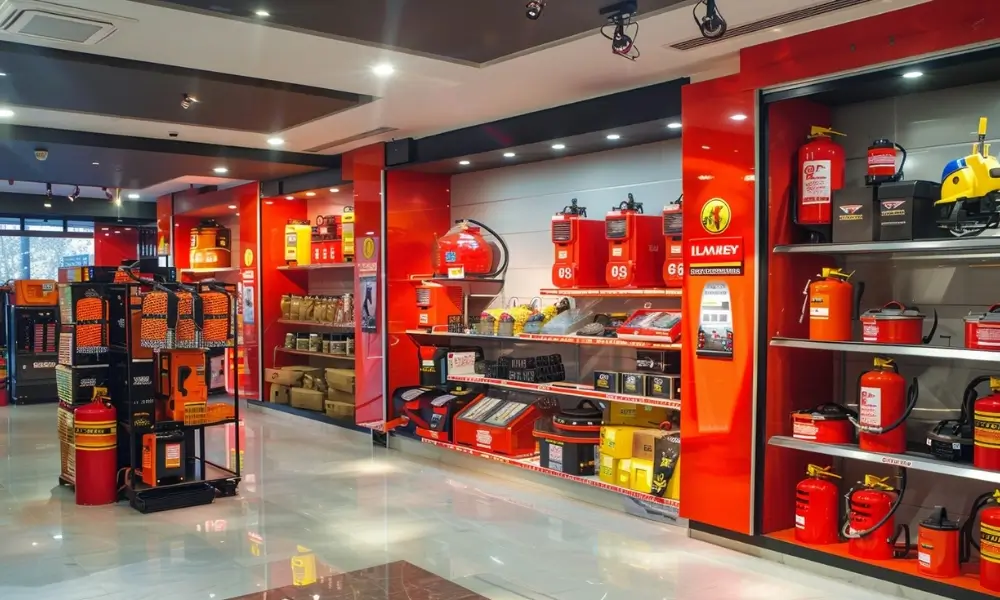
What is Fire Safety Equipment?
Fire safety equipment includes a variety of tools, devices, and systems designed to protect lives and property in the event of a fire. These critical tools help prevent fires, detect fires early, suppress flames, and facilitate safe evacuation. Common fire safety equipment includes fire extinguishers, sprinkler systems, smoke detectors, fire alarms, emergency lighting, fire blankets, fire doors, and specialized firefighting gear.
Understanding the role of fire safety equipment is essential for effective fire protection. Here’s how it works:
- 1.Preventing fires: Flame-retardant materials, fire safety plans, and proper storage of flammable items can stop fires before they start.
- 2.Detecting fires early: Smoke detectors, heat detectors, and gas leak detectors provide early warnings, giving occupants time to evacuate and helping firefighters contain the blaze.
- 3.Suppressing fires: Fire extinguishers, sprinkler systems, and suppression systems are designed to put out fires quickly and efficiently.
- 4.Safe evacuation: Emergency exit lights, fire doors, and clearly marked exits ensure safe and timely evacuation during a fire.
A comprehensive fire safety strategy includes regular fire drills, clear signage, and proper maintenance of all fire safety equipment to ensure the protection of both people and property.
Different Types of Fire Safety Equipment
Fire safety equipment includes a range of tools and devices that help prevent, control, and reduce the effects of fires in residential, commercial, and industrial settings. These critical tools protect lives and property, and the right equipment depends on the specific needs of a building or facility.
Here are some key types of fire safety equipment.
1,-Fire Extinguishers: Essential Tools for Fire Safety
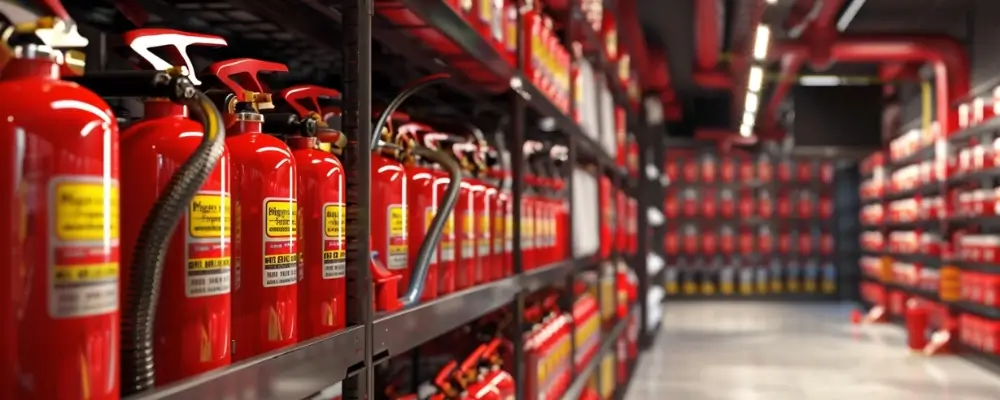
Fire extinguishers are crucial first-response tools for quickly tackling small fires before they escalate into larger, uncontrollable blazes. Choosing the right type of fire extinguisher depends on the class of fire you’re dealing with. Here’s a breakdown of the most common types of fire extinguishers and their uses:
- Water Extinguishers: Ideal for Class A fires involving ordinary combustibles like wood, paper, and fabric. Water extinguishers cool the burning material below its ignition point.
- Foam Extinguishers: Effective against both Class A and Class B fires (flammable liquids). The foam creates a barrier over the burning substance, cutting off the oxygen supply and cooling the fuel.
- Dry Chemical Extinguishers: Versatile extinguishers for Class A, B, and C fires (electrical equipment). They release a powder that interrupts the chemical reaction of the fire.
- Carbon Dioxide (CO2) Extinguishers: Primarily used for Class B and Class C fires, CO2 extinguishers displace oxygen and reduce heat with a cold discharge, making them ideal for electrical fires.
- Wet Chemical Extinguishers: Specially designed for Class K fires (cooking oils and fats) in commercial kitchens. They form a soap-like solution that cools and smothers the fire.
Using the correct fire extinguisher for the specific fire class ensures effective fire suppression and safety in any environment.
2,-Fire Sprinkler Systems: Automatic Fire Protection for Early Detection

Fire sprinkler systems are essential for automatic fire detection and suppression. These systems are connected to a reliable water supply and activate sprinkler heads when they detect heat in the fire’s vicinity. The sprinklers distribute water over the fire to control or extinguish it in its early stages, helping prevent the spread of fire, reduce damage, and save lives.
Sprinkler systems can be designed to protect entire buildings or specific high-risk areas, depending on the fire risk and building layout. Their immediate response is crucial for minimizing fire damage and preventing fatalities, making them an essential part of any fire protection strategy.
3,-Smoke Detectors: Essential for Early Fire Detection

Smoke detectors play a vital role in early fire detection, alerting occupants to danger before a fire spreads. These devices use either ionization sensors to detect smoke particles or photoelectric sensors to identify heat. When smoke or heat is detected, the alarm is triggered, providing a critical early warning.
Integrating smoke detectors with a building’s fire alarm system creates a comprehensive safety solution, enabling features like emergency lighting, voice evacuation messages, and automatic notifications to emergency services. This coordinated system ensures a swift and effective response to potential fires, safeguarding lives and property.
4,-Fire Hose Reels: Reliable Water Supply for Fire Fighting

Fire hose reels provide a steady, controllable supply of water to combat fires, making them an essential component of fire safety in large buildings. Typically installed in strategic locations, fire hose reels feature long hoses with adjustable nozzles for spray and jet functions, allowing flexible water control during emergencies.
Housed in protective cabinets to prevent damage, fire hose reels are always ready for immediate use. They are especially useful in large premises, where fires may require a more robust response than portable fire extinguishers can provide, ensuring maximum fire suppression capability.
5,-Fire Blankets: Effective Fire Safety Tools for Small Fires
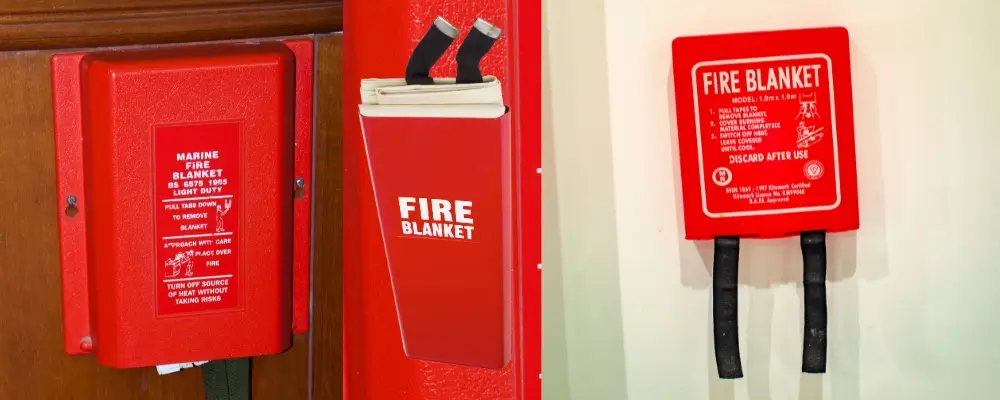
Fire blankets are essential fire safety devices made from fire-resistant materials like fiberglass. Designed to extinguish small fires in their early stages, fire blankets work by smothering flames and cutting off the oxygen supply needed for combustion.
Key Uses:
- Ideal for kitchen fires caused by cooking oil (Class K fires).
- Useful in laboratories for small-scale chemical fires.
- Can be used to wrap around individuals whose clothing has caught fire, offering immediate protection from burns.
Advantages:
- Easy to use with no maintenance required.
- Safe to use on people, unlike most fire extinguishers.
Fire blankets are a must-have for homes, kitchens, and laboratories for effective and quick fire suppression.
6,-Emergency and Exit Lights: Critical for Safe Evacuations

In the event of a fire, power outages and thick smoke can severely limit visibility. Emergency and exit lights are essential for illuminating pathways, exits, and critical areas during emergencies. These lights are equipped with backup power sources, such as batteries, ensuring they stay operational even if the main power supply fails.
Proper placement of emergency and exit lights is crucial for guiding occupants safely to emergency exits and assembly points, facilitating a quick and orderly evacuation.
When combined with other fire safety equipment, such as fire extinguishers, smoke detectors, and sprinkler systems, these lights form a comprehensive fire defense system. Regular maintenance, testing, and training are vital to ensure all safety equipment works effectively during an emergency.
7-Fire Doors: Essential for Passive Fire Protection
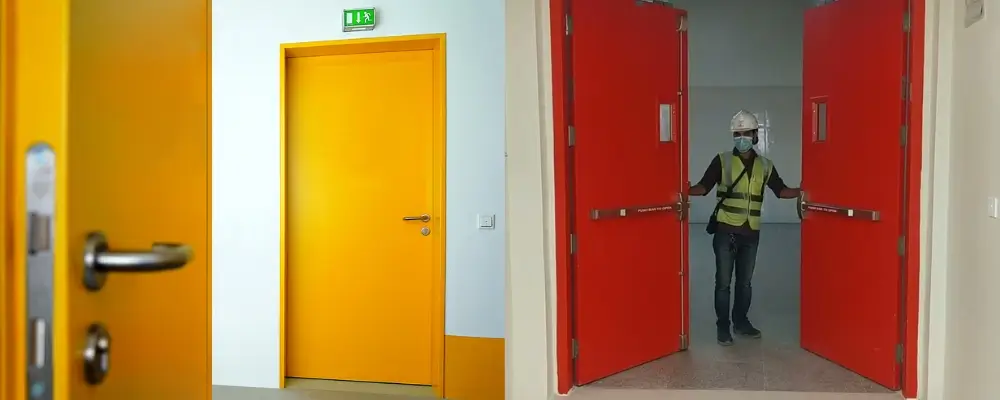
Fire doors are a crucial part of a building’s passive fire protection system, designed to prevent the spread of fire and smoke between different areas.
Construction:
- Made from fire-resistant materials like steel, timber, or gypsum.
- Fitted with seals that expand at high temperatures, blocking gaps to prevent smoke passage.
Operation:
- Fire doors close automatically during a fire, using fusible links or electromagnetic hold-open devices that release when the fire alarm activates.
Importance:
- Fire doors compartmentalize the building, containing the fire to a specific area and protecting escape routes.
- They provide occupants more time to safely evacuate by preventing the rapid spread of fire and smoke.
Fire doors play a key role in ensuring building safety by controlling fire spread and facilitating safe evacuations. Regular maintenance and inspection are vital for their effectiveness.
8,-Voice Evacuation Systems: Enhancing Fire Alarm Efficiency
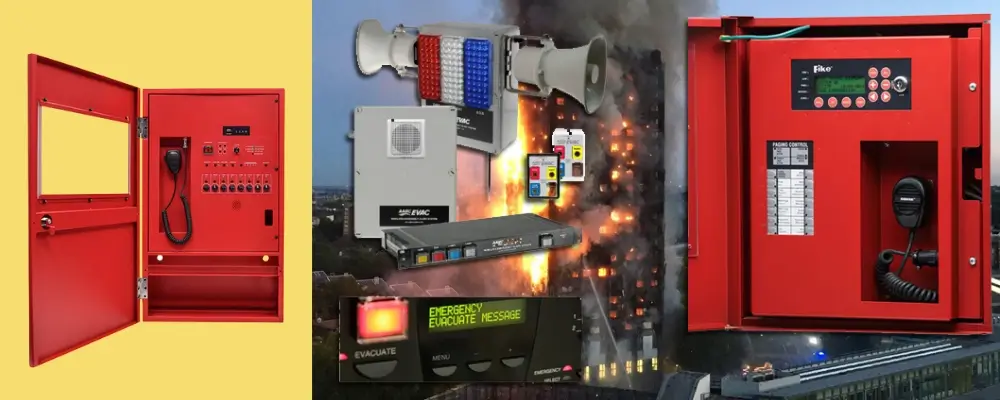
Voice evacuation systems are advanced fire alarm systems that use spoken messages to guide building occupants during an evacuation.
Efficiency:
- Voice evacuation messages are proven to be more effective than traditional alarm sounds. They provide specific instructions, reducing confusion and panic during emergencies.
Functionality:
- These systems deliver live or pre-recorded messages tailored to the emergency’s nature and location, including clear directions to the nearest safe exit.
Integration:
- Typically integrated with other fire safety systems, voice evacuation systems work in coordination with fire detection and suppression systems for a comprehensive emergency response.
Voice evacuation systems improve safety by providing clear and actionable guidance during a fire, enhancing overall evacuation efficiency and building safety.
9,-Fire Suppression Systems: Advanced Solutions for Fire Control
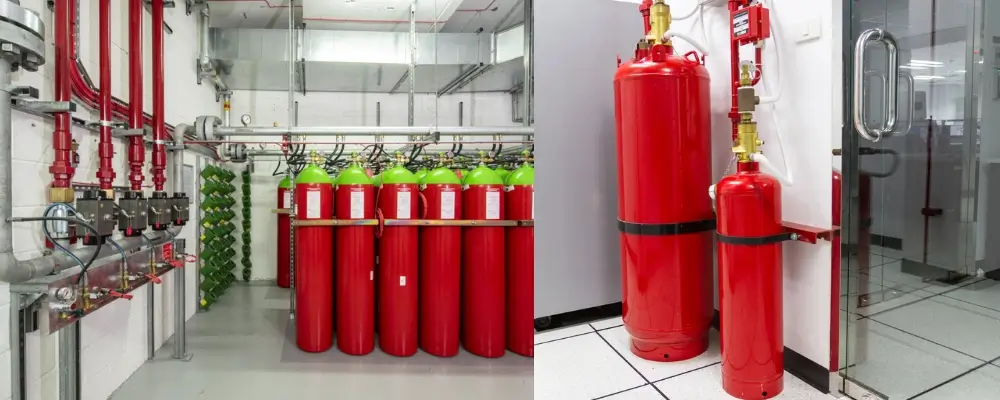
Fire suppression systems use various agents such as gases, chemicals, or foam to extinguish fires without causing water damage. These systems are essential for protecting sensitive environments and valuable assets.
Types and Uses:
- Gaseous Systems (e.g., FM-200, inert gases):
- Discharge gases that reduce oxygen levels or disrupt the fire triangle (fuel, heat, oxygen).
- Ideal for data centers, museums, and areas with valuable electronics or art.
- Chemical Wet Agents (e.g., potassium acetate-based agents):
- Effective for Class K fires (cooking oils and fats) in commercial kitchens.
- Cool the fire and create a layer that prevents re-ignition.
- Foam Systems:
- Used for Class B fires (flammable liquids) and sometimes Class A fires.
- Foam creates a barrier between the fuel and air, extinguishing the fire and preventing vapor release.
Advantages:
- Quickly extinguish fires without damaging sensitive equipment, documents, or artwork.
- Suitable for various environments, including server rooms, archives, and kitchens.
Fire suppression systems are crucial for effective fire protection. Their success relies on proper installation, regular maintenance, and the readiness of personnel to use them correctly in an emergency.
Additional Essential Fire Safety Equipment for Comprehensive Protection
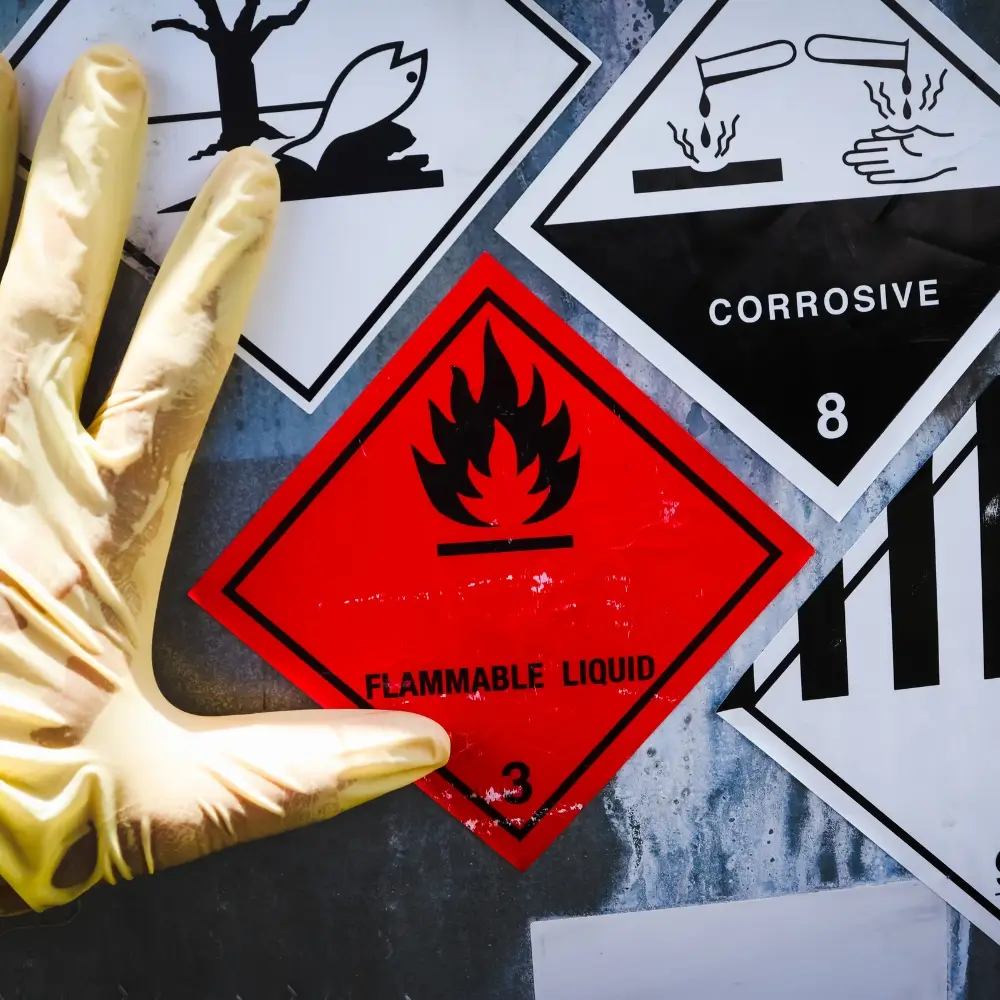
Beyond basic fire safety tools, there are advanced technologies and resources critical to enhancing fire safety in various environments.
Key Fire Safety Equipment:
- Automatic Fire Suppression Systems (AFSS):
- Detect and extinguish fires automatically using clean agents, water mist, or inert gases.
- Commonly used in data centers, libraries, and areas with hazardous chemicals.
- Firefighter Tools and Equipment:
- Includes specialized gear like fire axes, halligan bars, thermal imaging cameras, and self-contained breathing apparatus (SCBA).
- Essential for firefighting and rescue operations.
- First Aid Kits:
- Necessary for treating minor injuries post-fire. Kits should include burn dressings, bandages, and other basic supplies for immediate care.
- Fire Safety Plans and Signage:
- Detailed plans showing evacuation routes, assembly points, and fire safety equipment locations.
- Signage guides occupants to emergency exits and provides fire extinguisher instructions.
- Fire Dampers and Fire Stops:
- Installed in ducts and walls, these systems prevent the spread of fire and smoke through ventilation systems and fire-rated barriers.
- Gas Leak Detectors:
- Detect flammable gases in buildings with gas utilities, triggering alarms to prevent gas explosions or fires.
- Sprinkler Heads with Thermal Activation:
- Activated by heat to control water discharge, reducing water damage and targeting fire hotspots.
- Flame Retardants:
- Chemicals applied to materials like fabrics and wood to slow fire spread or prevent ignition.
- Emergency Response Plan (ERP):
- A well-documented ERP includes evacuation procedures, communication plans, and role assignments during a fire emergency.
Importance of Fire Safety Drills:
Regular fire drills based on these plans ensure occupants are well-prepared to respond to fire emergencies.
Integrating these advanced fire safety measures into your strategy enhances protection for lives and property in any setting.
Conclusion: The Vital Role of Fire Safety Equipment
In conclusion, fire safety equipment is crucial for effectively preventing, detecting, and combating fires. From fire extinguishers to emergency lighting, each tool plays a pivotal role in a comprehensive fire safety plan. Proper understanding and implementation of this equipment are essential for ensuring fire protection in homes, workplaces, and public spaces.
Knowledge of fire safety procedures and the correct use of fire protection systems significantly reduces the risk of fire-related injuries and fatalities. By being prepared and aware, you can help safeguard lives and property from the devastating effects of fire.
